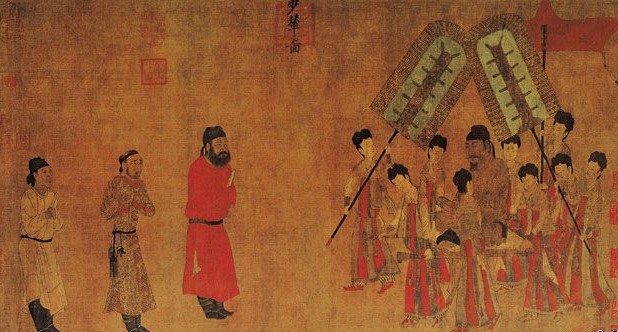
当前课程知识点:Clinical Histology > Chapter9 Digestive System > Parietal Cells in Stomach > Parietal Cells in Stomach
返回《Clinical Histology》慕课在线视频课程列表
返回《Clinical Histology》慕课在线视频列表
Hello everyone,
today we will talk about the digestive organ
--stomach.
Let's start with a case.
Rose is 29 years old.
She complained of pain in the upper belly
for the last two months.
Gastroscopic examination revealed an ulcer
in the lesser curvature of the stomach.
The doctor said the ulcer was caused
by the acidic gastric juice
that digested the tissue of stomach wall.
Rose wondered
where the acid in her stomach came from,
how was the wall of stomach protected normally,
and what condition might have caused her problem?
On completion of this session,
you should be able to identify
the basic structures
of stomach mucosa,
describe the morphology
and function of parietal cells
in gastric glands,
and explain some clinical correlates.
Stomach is the organ of temporarily
storing the masticated food bolus,
which enters the stomach from the oral cavity
through the esophagus.
The wall of stomach is made up of four main layers:
the mucosa, submucosa, muscularis, and serosa.
Stomach mucosa produces gastric juice that
contain proteases and hydrochloric acid.
Hydrochloric acid can kill or inhibit bacteria
and provide the acidic pH of 2
for the proteases to work.
The food boluses
are stored and converted into chyme,
partially digested food,
and finally to the small intestine
for additional digestion and absorption.
The production of gastric juice
is correlated to the function of
surface mucous cells
and the cells of gastric glands.
In this picture,
we can see the single layer of columnar epithelial
lining on the inner surface of the mucosa.
They also extend into the lamina propria
to form a gastric pit.
There are 1-4 tubular gastric glands
at the bottom of each pit.
So, products of surface mucous cells
and gastric glands
can be released
to the lumen through the gastric pits.
The simple columnar epithelium
produces a large amount of polysaccharide mucus
on the inner surface of the gastric lumen.
The mucus is synthesized in the cytoplasm
which is lightly stained
in the routinely prepared slides.
Because of the location and function of these
simple columnar cells,
we also call them surface mucous cells.
Beneath the gastric pit are gastric glands.
The glands distributed in the fundus
and body of the stomach are called fundic glands,
since the structures
in these two regions are similar.
There are 5 kinds of cells in the fundic glands:
parietal cells, chief cells, neck mucosal cells,
endocrine cells, and stem cells.
The cells with round or pyramidal morphology
and intensely eosinophilic cytoplasm
are parietal cells.
Parietal cells are mainly located
in the upper part of fundic gland,
secreting hydrochloric acid and intrinsic factor.
Under the electron microscope,
parietal cells
contain an extensive secretory network,
also called canaliculi.
Parietal cells
have an intensely eosinophilic hematoxylin
and eosin stain under light microscope.
A canaliculus
is a deep in-folding of the cytomembrane.
They are formed to increase the surface area
of the parietal cells for secretion.
The membrane of parietal cells is dynamic
when the cell is in different states.
In the resting state,
a number of tubulovesicular structures
can be identified in the apical region,
but there are few microvilli.
When activated to produce hydrochloric acid,
these vesicles fuse with the cell membrane
to form the canaliculi and microvilli,
thus providing an increase
in the surface of the cell membrane.
The large number of mitochondria
is responsible to produce ATP
for the active transport
of hydrogen and chloride ions.
These membrane structures
give the strong acidic appearance
of the parietal cells
in hematoxylin and eosin staining.
Hydrochloric acid
is released for protein digestion
and is also to keep the stomach immune
from infection.
The tissues of stomach wall also contain protein.
So, how can it manufacture acid and enzymes
without damaging its own tissue?
It is related to the mucus secreted
by the surface mucous cells.
Mucus is a mixture of water
and polysaccharide proteins
that causes it to become viscous and slippery.
The gastric mucosa produces so much mucus
that it insulates itself
from the contents and provides a barrier
to protect the stomach wall
from being digested by its own enzyme.
However, over-acidity in the stomach
will be beyond the protection of mucus,
and results in the acidic juice
eroding the tissue of the gastric mucosa,
forming an ulcer.
For a long time,
the hydrochloric acid was considered
the most important reason
for peptic ulcer.
While in 1982,
two Australian scientists, Warren and Marshall,
discovered and successfully cultured
the bacterium,
Helicobacter pylori,
from patients' stomach.
They found that the bacteria were correlated with
chronic gastritis(inflammation of the stomach)
and peptic ulcer.
H. pylori are spiral-shaped bacteria.
They are able to survive
in the strongly acid environment of the stomach.
Inside the mucus lining of the stomach,
the bacteria cannot be killed
by the immune system.
Their presence weakens the defensive barrier
and expose the stomach wall tissue
to digestive juices,
so leading to
inflammation and ulceration of the stomach.
In fact,
researchers believe that
H. pylori is responsible
for the vast majority of peptic ulcers,
about 80% of gastric ulcers
and 90% of duodenal ulcers.
Besides hydrochloric acid,
parietal cells also produce intrinsic factor.
Intrinsic factor is required for the absorption
of dietary vitamin B12 in the small intestine.
Vitamin B12
is needed for the development of red blood cells.
Long-term deficiency in vitamin B12 can lead to
pernicious anemia,
characterized by large fragile erythrocytes.
Atrophic gastritis is a process of
chronic inflammation of the stomach mucosa,
leading to loss of gastric glandular cells
and their eventual replacement
by the intestinal and fibrous tissues.
Therefore, atrophic gastritis,
particularly in the elderly,
is often associated with
the inability to produce intrinsic factor.
Decreased vitamin B12 absorption
leads to reduced red blood cells and anemia.
Parietal cell is just one of the cells
in the gastric glands.
We also have chief cells, neck mucosa cells,
endocrine cells, and stem cells.
Today we have mainly talked about
the structure of stomach mucosa,
the morphology and function of parietal cells.
The two most important functions are productions
of hydrochloric acid and intrinsic factor.
Here are the references.
Thank you for your attention!
-A Brief History of Histology
--A Brief History of Histology
-Test-A Brief History of Histology
-Characteristic Features of Epithelial Tissue
--Characteristic Features of Epithelial Tissue
-Covering Epithelium
-Specialized structures of Epithelial Tissue
--Specialized structures of Epithelial Tissue
-Test-Epithelial Tissue
-Wandering Cells
-Fibers and Ground Substances
--Fibers and Ground Substances
-Cartilage & Bone
-Test-Connective Tissue
-Blood & Hematopoiesis
-Test-Blood & Hematopoiesis
-Skeletal Muscle
-Cardiac Muscle
-Smooth Muscle
-Test-Muscle Tissue
-Myelin
--Myelin
-Cerebellum
-Test-Nerve Tissue and The Nervous System
-Heart
--Heart
-Capillaries
-Test-Circulatory System
-Thyroid
--Thyroid
-Adrenal Cortex
-Test-Endocrine System
-Tongue
--Tongue
-Parietal Cells in Stomach
-Large Intestine
-Liver
--Liver
-Pancreatic Islets
-Test-Digestive System
-From Nasal Cavity to Larynx
-From Trachea to Terminal Bronchiole
--From Trachea to Terminal Bronchiole
-Lung
--Lung
-Test-Respiratory System
-Nephron
--Nephron
-Test-Urinary System
-Seminiferous Tubules in the Testis
--Seminiferous Tubules in the Testis
-Ovarian Follicle
-Test-Reproductive System



